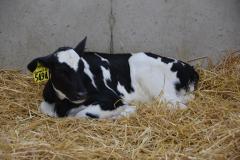Calf Survival and Future Milk Production Tied to Colostrum-Feeding
Calf Survival and Future Milk Production Tied to Colostrum-Feeding

Much has been written about the importance of feeding newborn calves adequate amounts of high-quality colostrum shortly after birth and rightly so. This management practice is one of the most important factors determining a calf’s health and survival the first 2 months of life and, as we now know, her future milk production. The recommendation for large breed calves includes feeding 4 quarts of high quality colostrum obtained from a properly-prepped cow using clean, sanitized milking equipment within the first 2 hours of life. But, why do scientists and industry representatives continually make this recommendation? By better understanding the why’s behind these recommendations, we can help those tasked with these chores understand the importance of following established protocols and the consequences when cutting corners.
Why are calves born without antibodies against common diseases?
Because of the structure of the placenta and uterine wall of cattle, antibodies are not exchanged between the fetus and its dam. As such, antibodies, known as immunoglobulins, are not transferred from the mother to fetus prior to birth and must be absorbed very shortly after birth. Absorption of these maternal immunoglobulins protects the calf against diseases until its own immature immune system can take over.
Why must colostrum be fed quickly after calving?
Immunoglobulins are large molecules and require a special process to be absorbed into the blood stream of the calf. The efficiency of absorption of immunoglobulins decreases with age of the calf, is the highest within the first hour of birth, decreases quickly with age, and essentially is non-existent by 24 hours of age. Thus, the recommendation to feed adequate amounts of colostrum within the first hour or two of birth or as quickly as the calf is discovered.
Why should calves drink 4 quarts at the first feeding?
Holsteins and other large breed calves should be fed 4 quarts of colostrum (Jerseys- 3 quarts) at the first feeding. Studies have shown that Holstein calves given 4 quarts versus 2 quarts of colostrum within 4 to 6 hours of life, give more milk as first calf heifers. Calves may not drink all of this allocation in one feeding and, as such, should either have the remainder tubed using an esophageal feeder or provided within a second feeding within the first 6 hours of life.
Besides immunoglobulins, colostrum contains nutrients needed by the calf for survival and body temperature regulation. Colostrum contains increased concentrations of total solids, fat, protein and numerous minerals and vitamins compared to whole milk. Several non-nutritive components found in colostrum are extremely important in the development of the immune system needed to fight off diseases and are also important in the development of the cells in the intestine so these cells will absorb more nutrients needed to increase milk production later in life.
Why is cleanliness important when harvesting and feeding colostrum?
Colostrum needs to be collected from properly cleaned udders in a clean, sanitized bucket/pail and fed through clean, sanitized storage and feeding equipment. High bacterial loads in fresh or refrigerated colostrum (greater than 100,000 cfu/mL total plate counts or 10,000 cfu/mL total coliform count) have been shown to interfere with colostrum immunoglobulin absorption. Also, studies have shown that calves fed colostrum low in bacterial numbers early in life have a more rapid colonization of beneficial bacteria in the intestines and less potential colonization of scour-causing bacteria.
Why should colostrum be tested for antibody concentrations?
Immunoglobulin concentration of colostrum varies between cows. Jerseys have a higher concentration of immunoglobulins than Holsteins. Cows with shortened dry periods (60 versus 40 days) and those where harvesting of colostrum was delayed after calving have lower concentrations of immunoglobulins. Thus, colostrum should be tested to insure calves receive adequate amounts of immunoglobulins. A Brix refractometer measures the percentage of solids in a solution which is correlated to the amount of IgG in colostrum and 90% or more samples of colostrum should have a reading greater than or equal to 22%.
Author: Donna M. Amaral-Phillips
